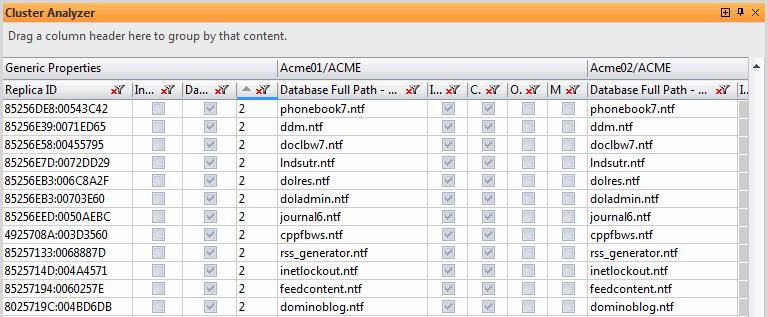The Cluster Analyzer
The Cluster Analyzer
The Cluster Analyzer provides a quick and extensive overview of your clusters.
Select a server you would like to analyze and replicationEZ will find the cluster it belongs to along with all cluster-mates. ReplicationEZ will work with the Cluster Directory Database on the primarily selected server, and display its contents in the Cluster Analyzer panel.
Comparing cluster-mates side by side
This screeshot shows all databases and related properties (contained by the Cluster Directory Database) under a single column header for each server; Acme01 or Acme02.
Examples: Getting a global overview of your cluster. ( It's as easy as 1, 2, 3 )
1- Quickly highlight inconsistencies between the settings for databases set in the Cluster directory.
2- Check the effective presence of the related databases on the server and spot any discrepancies between the Cluster Directory and the real world.
3- Instantly see duplicates and missing replicas among your clusters.
Column headers
Generic Properties
- Replica ID : Display the Replica ID of the Domino databases. All replicas share a replica ID which is assigned when the database is first created. If the database replica IDs are identical, replication can occur between them.
- Inconsistency Found : The Cluster Analyzer tool highlights inconsistencies between the settings for databases set in the Cluster Directory.
- Database On Servers : This is checked if the database is located on the selected servers.
- Number of Replicas : This displays the 'Number' property of the Replica ID for any selected database . This helps to reveal duplicate Replicas IDs.
Clustered Domino Servers fields
- Database Full Path : Displays the Domino path of the database. From the Domino point of view, the root folder starts on the data folder.
- Is On Server : Indicates if the database is on the selected server.
- Cluster Replicate : Displays if the cluster replication is enabled (marked) or disabled (unmarked) for the selected database.
- Out Of Service : Displays the databases marked Out Of Service. A clustered database can be marked Out Of Service to make database unavailable for user access.
- Marked for Delete : Displays if the selected database is marked for deletion. Clustered database replicas can be marked for deletion, this flag means that the database will be deleted after all current users exit the database.
